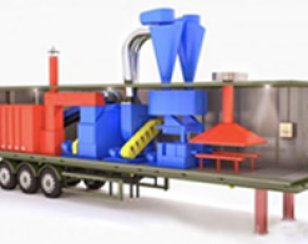Drying in the aerodynamic dispergator
When dispergator is working, material is moved to dispergator through special loading gate and gets to rotor with blades. Material collides with blades and grinds, under inertial forces material particles tend to leave dispersion area. At the same time fan blows down air through dispergator in order to return material particles to grinding area, so, the generation of air-fluidized material bed at outer radius of horn rotation is executed. Particles traverse speed in air-fluidized bed is lower, than rotor traverse speed, that executes energy, which is necessary for material grinding. Material drying is executed owing to intensive air change. Air flow, providing drying of material, is up to 30 000 m3/hour, the flow rate is 25-28 meters/second relative to material particles, which are in a fluidized bed. Effective drying is executed when the air of temperature is 120 - 150 ° C, the approximate rate of thermal energy is 750-800 kW. to 1 tonne evaporated moisture. Grinding and drying of material is executed until material particles reach necessary size and humidity.
In working area of aerodynamic dispergator simultaneous processes of material drying and grinding execute, that leads to decreasing of drying time and energy consumption.
Material drying in aerodynamic dispergator is assured by intensive air-mass exchange, which is the result of technical solution of this equipment. Material particles are held in drying-grinding zone by inertial forces. Material particles form fluidizated bed at the outer radius of horn rotation, through it desiccant agent is blown – air. Airflow, which assures material drying, is 30.000 cubic meter/hour, flow rate is 25-26 metres/second relative to material particles, which are in fluidizated bed.
The principle of inertial separation is used in aerodynamic dispergator. Inertial separation is a selection of material particles, which have necessary characteristics, it executes from drying-grinding area. As a result of inertial separation material particles are passed away only with necessary humidity.
Drying process in aerodynamic dispergator also increases owing to intensive friction and collision of particles with each other in dense velocity (fluidizated) layer by motion with high circumferential velocity in aerodynamic dispergator. It’s acceptable to use heat carrier with temperature range to 250 C.
|
|
|
|

